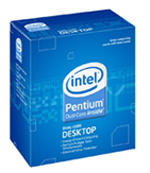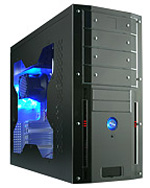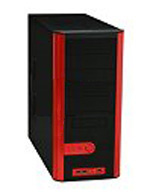System Buyers Guide: PCs for Under $1000
by Wesley Fink on December 29, 2008 3:00 AM EST- Posted in
- Guides
Intel Entry-level PC
While Intel still owns the top of the CPU performance charts, the area from midrange to entry is very competitive between Intel and AMD. The one advantage that remains for Intel is that their processors generally overclock much better than current AMD CPUs. This is not normally a consideration in entry computers, but it could be for some buyers.
| Intel Entry-level PC | ||
| Hardware | Component | Price |
| Processor | Intel Pentium Dual-Core E5200 Wolfdale (Dual-core 2.5GHz 65W 2MB Shared L2 800FSB) |
$83 |
| Cooling | CPU Retail HSF | - |
| Video | Onboard | - |
| Motherboard | Zotac N73PV-Supreme NVIDIA GeForce 7100 HDMI | $60 |
| Memory | Kingston 4GB DDR2-800 Kit (KVR800D2N5K2/4G) | $37 |
| Hard Drive | WD Caviar GP WD5000AACS 500GB | $59 |
| Optical Drive | Samsung 22X DVDRW/DL SH-S202G | $25 |
| Audio | Onboard | - |
| Case | Rosewill TU-155 with 400W | $60 |
| Power Supply | Included with Case | - |
| Display | Hanns-G HB-175APB 17" 8ms Widescreen LCD Monitor Built in Speakers - Retail (1440x900) | $99 |
| Speakers | Built-in Monitor | - |
| Input | Microsoft CA9-00001 PS/2 Standard Keyboard and Optical USB/PS2 Mouse - OEM | $16 |
| Operating System | Microsoft Vista Home Premium OEM | $99 |
| Bottom Line | $538 | |
 |
Our choice for the Intel entry CPU is the excellent 2.5GHz dual-core E5200 Wolfdale. This 65W CPU uses 800FSB, so right out of the box the first option for overclock, if you are so inclined, is to bump the FSB up to 1066. Even if you never overclock you will be very pleased with the performance of the E5200. We do not recommend going lower than an E5200 in an Intel system because the tradeoffs in performance for the few dollars saved are too great. The E1200 at $53, for example, is dismal compared to the E5200, and certainly not a good choice in performance for the $30 saved.
 |
In the past year, some motherboards for Intel systems have finally reached price parity with AMD systems. One example is the Zotac board chosen for the entry Intel system. The ZOTAC N73PV-Supreme is based on the GeForce 7100. This uATX motherboard features HDMI output, Gigabit LAN, four 3Gb/s SATA ports, 10 USB ports, HD audio, one PCI-E x16 slot, one PCI-E x1 slot, two PCI slots, and support for 4GB RAM. This board offers excellent stability and performance for the money. Pair it up with an E5200 and 4GB of DDR2-800 and you have a solid SOHO system
 |
The rest of the components are virtually identical to the AMD entry-level system. This includes the Rosewill TU-155 case with 400W PSU from Newegg. It is a versatile case that will house any entry to midrange system at a current cost of $60. The TU-155 with PSU often goes on sale for $50 so it pays to shop if it is important to save every dollar possible. We generally do not recommend cases that come with a power supply, but our long-term experience with this 400W PSU has been positive with no problems - though certainly efficiency isn't going to compete with PSUs that cost as much on their own as this case/PSU combo. If you're interested in getting a better quality, higher efficiency 300-450W PSU, we'll have a couple massive roundups in the near future, so check back later this week.
 |
A good case alternative is the well-known Cooler Master Centurion 5 Red FR-T05-URI-GP with 430W power supply for the same $60. This black case with red trim stands out in both appearance and in its flexible interior that can handle five 5.25" devices, two 3.5" devices, and three internal hard drives. There is also an installed 120mm exhaust fan on the rear in the CPU area.
If we compare the two entry-level systems, the winner depends on what you value most. The Intel system is a bit more powerful, but you can move up to a high-end Athlon 64 X2 or a low-end AMD Phenom X3 for comparable performance at less than $100. The full-size AMD ASRock board offers more flexibility for future graphics expansion, with two x16 PCIe slots and Crossfire X support. If you are a gamer on a strict budget, the AMD entry system offers you more options for future graphics expansion. For the typical entry-level PC right now, and for what the system is typically used for - internet, office, low-end gaming, and low to mid graphics - you can go either route and be happy.










38 Comments
View All Comments
naveensn - Saturday, March 28, 2009 - link
I built the AMD budge computer with more or less the components that you had in your article. This was the first time I did this and was much easier that I thought it would be.The computer is up and running and I installed Ubuntu also on that. Thanks for the info.
Naveen
HHumbert - Friday, January 9, 2009 - link
I copied the article and friggen Newegged everything on here. Here goes nothing, as I've never built a PC before. Which is funny, because I majored in Electric Engineering, and I've had Investment Banker friends put together PCs, and I have lacked the testicular fortitude to do so.Finally. Thanks for this very well-written guide. I'll come back on after it arrives and let you know how it goes. Any idea how long it takes to slam together one of these things?
I took the path of putting together the INTEL Budget PC with the Radeon 4870 GPU.
My situation is that I have an Inspiron 1520 laptop that I've been gaming on (COD:WaW), Crysis 2 (when I get a more powerful computer, but it's getting long in the teeth, even with a dedicated GPU on the laptop.
So, I'm building this first one for our weekend house and want to get it to play movies on the home theatre (I also ordered LG BR/HD drive for it).
If that goes well, I'll be buying another one of these systems for the downtown house so I can have dual setups.
Thanks again!
Ryphil - Monday, January 26, 2009 - link
If this is your first assembly, be patient and don't cut corners. Plan for a few quiet, uninterrupted hours for the task at hand. So assuming you don't run into any problems that can't be fixed on the spot, you should be able to slam this together in 30 minutes to two hours. And don't forget thermal compound for the processor's heat sink! Let me know how this went for you if you get a sec.Mozee - Friday, January 9, 2009 - link
Here's a question, since I'm building a system with very similar specs to the AMD Budget System. If you increase the video card from the ATI HD4830 to an HD4850, would you still be able to use the 400W power supply, or would that require a higher powered psu?Malachi9 - Monday, January 5, 2009 - link
Be careful with cases containing an Imon LCD - Silverstone, Anatec, Thermatech. There is a serious bug which connects and disconnects the USB hub causing pauses in games e.g PES 2009. I have the LC16M and have to physically disconnect the LCD to play games.djhunt - Saturday, January 3, 2009 - link
First, I wanted to say thanks for these buyer guides. I used the mid-range guide four years ago to build my first system. For someone who can't keep up on all the latest hardware, these guides are a great starting point.Now I'm looking to do a replacement based on the Intel budget recommendation. I've tweaked a few items to get a quieter system (my current system whines like a jet engine), but I'm stuck on what to do for a video card. I don't have serious video requirements (minimal gamer, no HTPC) but would probably like something a little above onboard video. Since the GIGABYTE GA-EP45-UD3R doesn't have onboard video, what should I get? I'm currently looking at the ASUS EAH4350 SILENT/DI/512MD2 Radeon HD 4350, but not sure if it's any good. Recommendations under $75 or so?
bearxor - Sunday, January 4, 2009 - link
Thought about one of the newer GF9400 Motherboards?http://www.newegg.com/Product/Product.aspx?Item=N8...">http://www.newegg.com/Product/Product.aspx?Item=N8...
Wesley Fink - Saturday, January 3, 2009 - link
The Asus Silent HD 4350 sounds like a good choice in line with the requirements you describe. It is not nearly as powerful as the Powercolor HD 4830 at $85 that we selected, but since silence is your major requirement the Asus will likely meet your needs better.Martin84a - Saturday, January 3, 2009 - link
Hi, you don't mention a lot about the ram which is a shame, because a lot of these guides are read by people that have been away from the hardware scene for a while, eg. like me. I haven't upgraded my PC since 2003, but know i felt it was the time. But while it is fairly easy to read a CPU review and compare the results, it is a jungle of chipsets and motherboards out there, and they of course affect your choice of RAM.I was actually going with an Asus P5Q Pro, because of good reviews and its Loadline Calibration, which eliminates the Vdrops that happens under load. See http://www.hardwarecanucks.com/forum/hardware-canu...">http://www.hardwarecanucks.com/forum/ha...p5q-pro-...
But now i see your EP45-UD3R recommendation..
Gigabyte - Asus
AWARD vs AMI bios.
1x PCI-E vs 2x PCI-E (Can do crossfire as well)
Realtek ALC889A soundchip vs Realtek ALC1200
3x PCI vs 2x PCI
Not sure about EP45-UD3Rs warranty, but the P5Q Pro has 3 years of warranty.
Then there is the matter of how good BIOS and driver support there is, and when it will stop. No clue here though :(
But overall, the Asus P5Q Pro is a bit cheaper, and comes with 2x PCI-E, and i just love that Loadline Calibration, i mean look at that straight line. Would you still pick the Gigabyte?
Thanks.
SleepyItes - Thursday, January 1, 2009 - link
The HTPC truly is a "very personal machine", and I'm glad that you mentioned this in the beginning of the HTPC segment. I just finished a budget HTPC for under $400 (granted I used an existing HDD, TV Tuner, and OS license) and I can say that the choices in this market segment are vast, and require careful evaluation of particular requirements and considerations. I toyed around with various configurations and price ranges before I finally found the balance that was right for me. Home theater organization, TV resolution, gaming needs, and budget all played a role in component selection.I started with a case that would fit nicely with my A/V rack, the Antec NSK 2480. I found an excellent deal on a CPU/Mobo combo at an unnamed local vendor. I was building this for a low-ish resolution TV (1280x768) so I chose not to go with blu-ray, which saved me a bundle. I wanted discreet graphics to be able to do some casual gaming. However, since I have such a low resolution TV (and such old games), I did not even need a mid-range card. Instead, my focus was on power consumption, so I decided to go with a Radeon HD 4670. Sure, for $10 more (after rebate) I could have gotten the 4830, but it uses a lot of power, runs hot, and takes up a lot of space (which is at a premium in an HTPC case).
I'm just reinforcing the notion that building an HTPC is not about pure performance, features, or bang for buck. It's about building a system that fits into your entertainment center and satisfies your particular needs.
Fantastic guide! I cannot wait to read next week's.